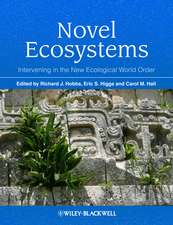Antarctic Ocean and Resources Variability
Editat de Dietrich Sahrhageen Limba Engleză Paperback – 5 dec 2011
Preț: 651.34 lei
Preț vechi: 766.28 lei
-15% Nou
Puncte Express: 977
Preț estimativ în valută:
124.67€ • 135.47$ • 104.79£
124.67€ • 135.47$ • 104.79£
Carte tipărită la comandă
Livrare economică 21 aprilie-05 mai
Preluare comenzi: 021 569.72.76
Specificații
ISBN-13: 9783642737268
ISBN-10: 3642737269
Pagini: 320
Ilustrații: XI, 304 p.
Dimensiuni: 210 x 280 x 17 mm
Greutate: 0.72 kg
Ediția:Softcover reprint of the original 1st ed. 1988
Editura: Springer Berlin, Heidelberg
Colecția Springer
Locul publicării:Berlin, Heidelberg, Germany
ISBN-10: 3642737269
Pagini: 320
Ilustrații: XI, 304 p.
Dimensiuni: 210 x 280 x 17 mm
Greutate: 0.72 kg
Ediția:Softcover reprint of the original 1st ed. 1988
Editura: Springer Berlin, Heidelberg
Colecția Springer
Locul publicării:Berlin, Heidelberg, Germany
Public țintă
ResearchDescriere
During the intensification of research activities in the Southern Ocean in recent years, both at national levels and through international cooperation in such projects as BIOMASS with its FIBEX and SIBEX phases, the need was felt increasingly for closer collaboration between biologists, meteorologists, and oceanographers in the study of the interaction between the atmospheric forces, the water masses, and the living resources. Better knowledge in this regard is not only of scientific interest but also of practical importance, especially for the management of the resources and the protection of the Antarctic marine ecosystem. As a follow-up on a recommendation by the IOC Program Group for the Southern Oceans made in March 1983, the Intergovernmental Oceanographic Commission organized a meeting of experts on oceanography related to the dynamics of the Antarctic ecosystems. During this meeting, held in Kiel, Federal Republic of Ger many, in May 1984, biologists and oceanographers involved in BIOMASS activities met with the oceanographers of SCOR Working Group 74 to discuss ways and means for additional physical and chemical observations in the oceanographic research within BIOMASS. It was the time when large fluctuations in the distribution of krill with subsequent detrimental effects on predator species dependent on krill had just been observed, and the question arose whether this was possibly the result of changes in the Antarctic water circulation.
Cuprins
1 Meso/Large-Scale Variability in the Environment.- A Survey of the Atmospheric Elements at the Ocean’s Surface South of 40°S.- Variability of the Atmospheric Circulation over the Drake Passage, Scotia Sea and Weddell Sea.- Some Indications for Environmental and Krill Resources Variability in the Southern Ocean.- Spatial and Temporal Variability Within the Southern Ocean.- Upper Ocean Characteristics in Drake Passage and Adjoining Areas of the Southern Ocean, 39°W-95°W.- Variation of Geostrophic Circulation off the Antarctic Peninsula and in the Southwest Scotia Sea, 1975–1985.- Variation of Positions and Structures of the Oceanic Fronts in the Indian Ocean Sector of the Southern Ocean in the Period from 1965 to 1987.- 2 Meso/Large-Scale Variability in the Biota (Related to the Environment).- Seasonal and Interannual Variabilities in Antarctic Phytoplankton with Reference to Krill Distribution.- Scales of Interaction Between Antarctic Krill and the Environment.- Interannual Variability in Estimated Primary Productivity of the Antarctic Marginal Ice Zone.- Effects of Pack Ice on the Composition of Micronektonic Communities in the Weddell Sea.- Patterns of Spatial and Temporal Distribution and Their Variation in Early Life Stages of Antarctic Fish in the Antarctic Peninsula Region.- The Pelagic Ecosystem of the Bransfield Strait, Antarctica: An Analysis of Microbiological, Planktological and Chemical Characteristics by Multivariate Analyses.- 3 Krill Variability in Relation to the Environment.- Large-Scale Fluctuations in Distribution and Abundance of Krill — A Discussion of Possible Causes.- Hydrography, Krill and Fish and Their Possible Relationships Around Elephant Island.- Can We Satisfactorily Estimate Variation in Krill Abundance?.- Patterns of Fluctuations in the Hydrological Conditions of the Antarctic and Their Effect on the Distribution of Antarctic Krill.- Differences in the Hydrology, Biomass, and Species Distribution of Plankton, Fishes, and Birds in the Bransfield Strait and the Drake Passage During FIBEX 1981 and SIBEX 1983/84.- A Concept of Seasonal Variation of Krill (Euphausia superba) Distribution and Abundance West of the Antarctic Peninsula.- Variability in Population Density of Antarctic Krill in the Western Scotia Sea in Relation to Hydrological Conditions.- Formation of Antarctic Krill Concentrations in Relation to Hydrodynamic Processes and Social Behaviour.- Variability in the Physical and Biotic Environment of the Antarctic Krill (Euphausia superba Dana), South of Africa: Some Results and a Conceptual Appraisal of Important Interactions.- 4 Krill Variability Detected from Predator Studies.- Reproductive Performance of Seabirds and Seals at South Georgia and Signy Island, South Orkney Islands, 1976–1987: Implications for Southern Ocean Monitoring Studies.- Long-Term Trends in the Foraging Patterns of Female Antarctic Fur Seals at South Georgia.- Squid as Predators on Krill (Euphausia superba) and Prey for Sperm Whales in the Southern Ocean.- Summary and Conclusions.












